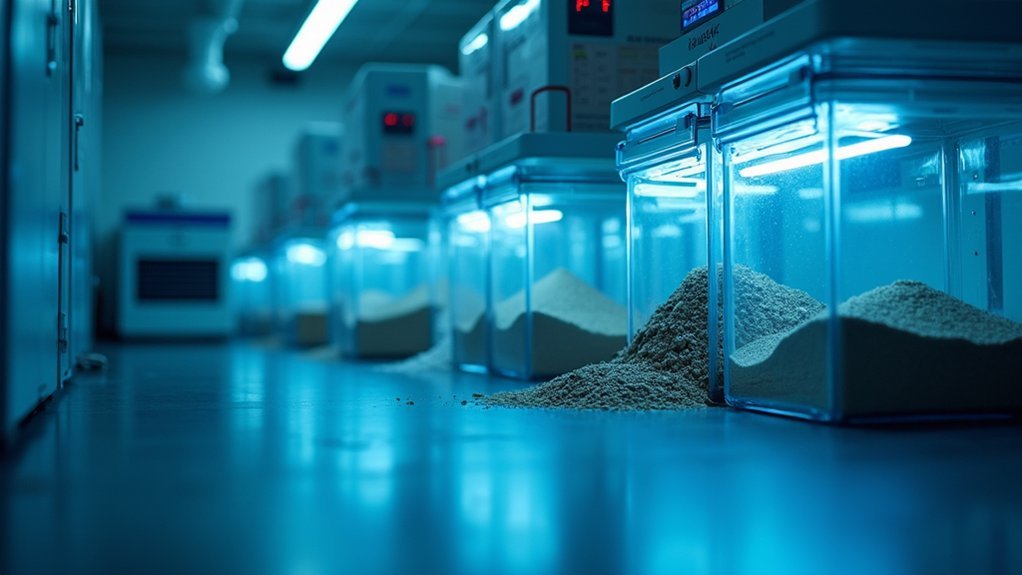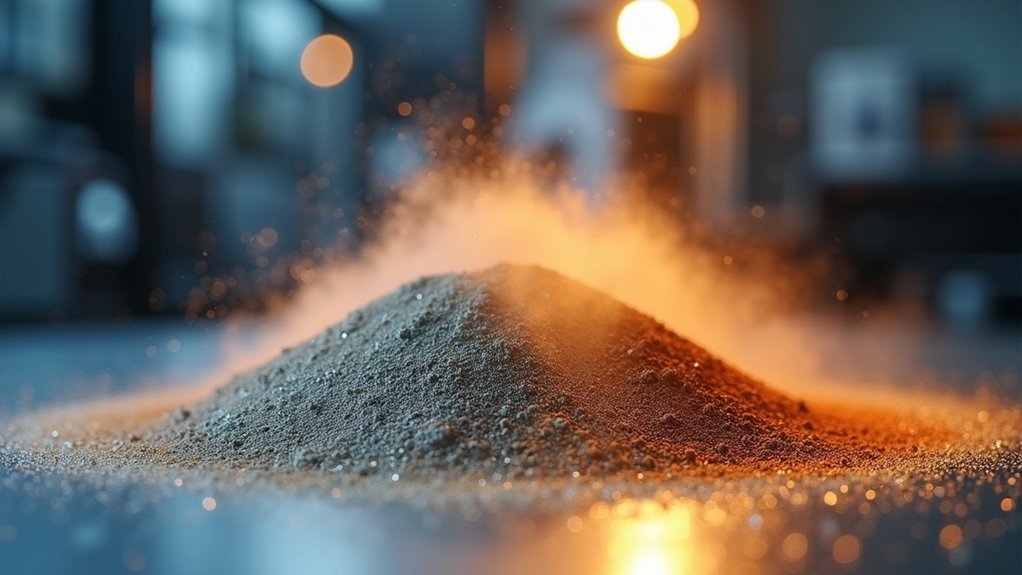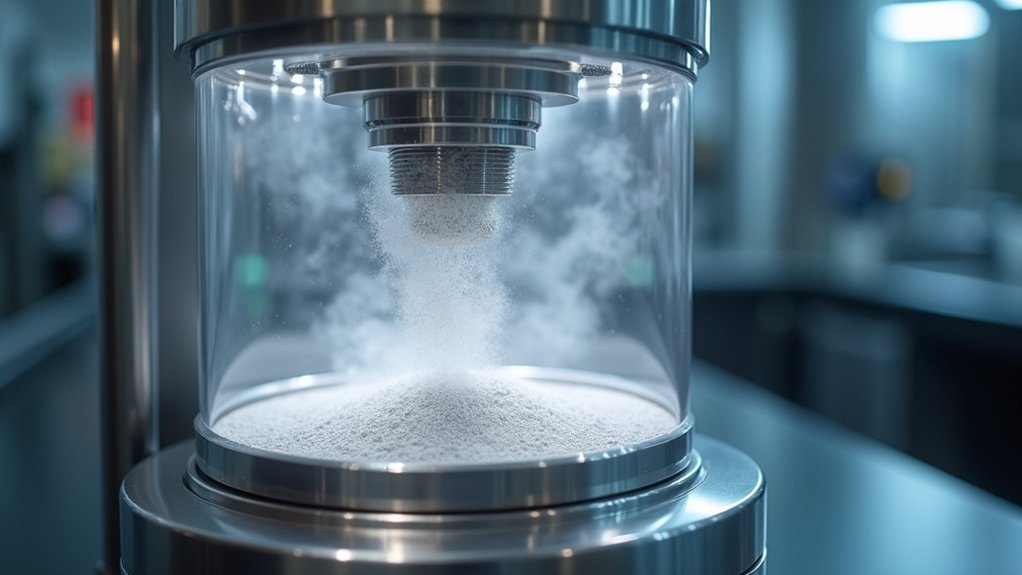You can prevent metal powder oxidation through five key strategies: maintain controlled storage conditions with temperatures between 20-25°C and humidity below 50%, use airtight containers with non-reactive materials and nitrogen purging, apply protective surface treatments like powder coatings or phosphating, establish regular inspection protocols to catch early oxidation signs, and utilize inert gas atmospheres for long-term protection. These methods work together to eliminate oxygen exposure, control moisture, and create protective barriers that preserve your metal powder’s integrity and extend its usable life considerably.
Maintain Controlled Environmental Conditions During Storage

To prevent metal powder oxidation effectively, you’ll need to control the storage environment meticulously.
Temperature control is essential—maintain storage areas between 20°C to 25°C to prevent condensation and thermal expansion that accelerate oxide formation.
You’ll also need to manage humidity levels aggressively. Install dehumidifiers to keep relative humidity below 50%, as moisture dramatically increases oxidation rates.
Store your metal powders in airtight containers to minimize oxygen exposure.
Consider implementing nitrogen or argon gas purging to create an inert atmosphere that completely eliminates oxidation reactions.
Don’t forget to monitor conditions regularly using hygrometers and thermometers.
This controlled approach guarantees your storage environment remains within ideal ranges, effectively preventing the formation of unwanted oxides that compromise powder quality and performance.
Implement Proper Airtight Container Systems
Beyond environmental controls, your choice of storage containers directly impacts oxidation prevention success.
You’ll need airtight systems that create a barrier that prevents oxygen and moisture from reaching your metal powders. Select containers made from non-reactive materials that won’t compromise powder integrity. Before sealing, purge containers with nitrogen or argon gas to establish an inert atmosphere that’ll prevent rust and corrosion formation.
Regular seal inspections are essential—any breach allows air infiltration that undermines your protective layer. Label each container with sealing and expiration dates to guarantee timely usage.
Compromised seals spell disaster for metal powder storage—inspect regularly and track dates to maintain your oxidation defense system.
This systematic approach works alongside controlled humidity and temperature conditions, creating thorough protection. While some powders have protective coatings, proper container systems remain your primary defense against oxidation during extended storage periods.
Apply Protective Surface Treatments to Metal Powders

Several protective surface treatments can dramatically extend your metal powders’ resistance to oxidation by creating physical and chemical barriers.
These methods form defensive layers that prevent moisture and oxygen from reaching the metal surface, effectively stopping rust formation before it starts.
You can implement three primary protective surface treatments:
- Organic paints and powder coatings – Create an impermeable barrier against environmental moisture and oxygen exposure.
- Surface treatments like phosphating and passivation – Enhance the natural oxide layer to provide superior corrosion resistance.
- Electroplating with corrosion-resistant metals – Apply thin protective metal layers that act as sacrificial shields.
Remember to regularly inspect and maintain these protective coatings on your stored metal powders to guarantee continued effectiveness against oxidation over time.
Regular Inspection and Contamination Removal Protocols
While protective surface treatments provide excellent defense against oxidation, you’ll need consistent monitoring and cleaning protocols to maintain your metal powders’ long-term integrity. Regular inspections help you identify early signs of oxidation like discoloration or surface changes before they cause significant degradation.
Your contamination removal protocol must address moisture, dust, and other particles that accelerate oxidation. Use clean storage containers and implement routine cleaning procedures for all handling equipment and areas.
| Monitoring Factor | Action Required |
|---|---|
| Humidity levels | Keep below 30% RH |
| Container cleanliness | Weekly sanitization |
| Powder appearance | Daily visual checks |
| Storage environment | Temperature control |
Environmental monitoring proves critical since high humidity dramatically increases oxidation risk. Consider inert gas purging systems to displace oxygen and moisture from your metal powders storage facilities.
Utilize Inert Gas Atmospheres for Long-Term Protection

When oxygen and moisture threaten your metal powders’ integrity, inert gas atmospheres provide the most reliable long-term protection available.
You’ll create a protective barrier that displaces harmful elements and maintains your pure materials throughout storage and processing.
Implementing inert gas systems offers three critical advantages:
- Complete oxygen displacement – Argon and nitrogen effectively eliminate oxidizing agents from your storage environment.
- Enhanced material purity – You’ll prevent unwanted oxide formation that compromises powder performance and quality.
- Extended shelf life – Your investment in metal powders maintains value longer through reduced chemical reactions.
For reactive metals like aluminum and titanium, inert gas atmospheres aren’t optional—they’re vital.
You must monitor gas levels regularly to prevent oxidation and guarantee continuous protection of your materials.
Frequently Asked Questions
How to Prevent Powder From Oxidizing?
Store your powder in airtight containers with desiccants, use inert gas atmospheres during handling, apply protective coatings like oil, and control storage temperatures to prevent oxidation from moisture and oxygen exposure.
How Can You Prevent Metal Oxidation?
You can prevent metal oxidation by applying protective coatings like paint or galvanization, using corrosion-resistant metals, controlling environmental conditions, adding chemical inhibitors, and performing regular maintenance inspections.
How to Remove Oxidation From Powder Coated Metal?
First, you’ll clean the surface with mild detergent and water. Then use a non-abrasive cleaner designed for powder-coated surfaces to gently scrub oxidized areas without damaging the coating underneath.
How Can We Prevent Oxidation?
You can prevent oxidation by applying protective coatings, using inert atmospheres during storage, controlling humidity and temperature, regularly cleaning contaminants, and adding antioxidant additives during manufacturing processes.





Leave a Reply